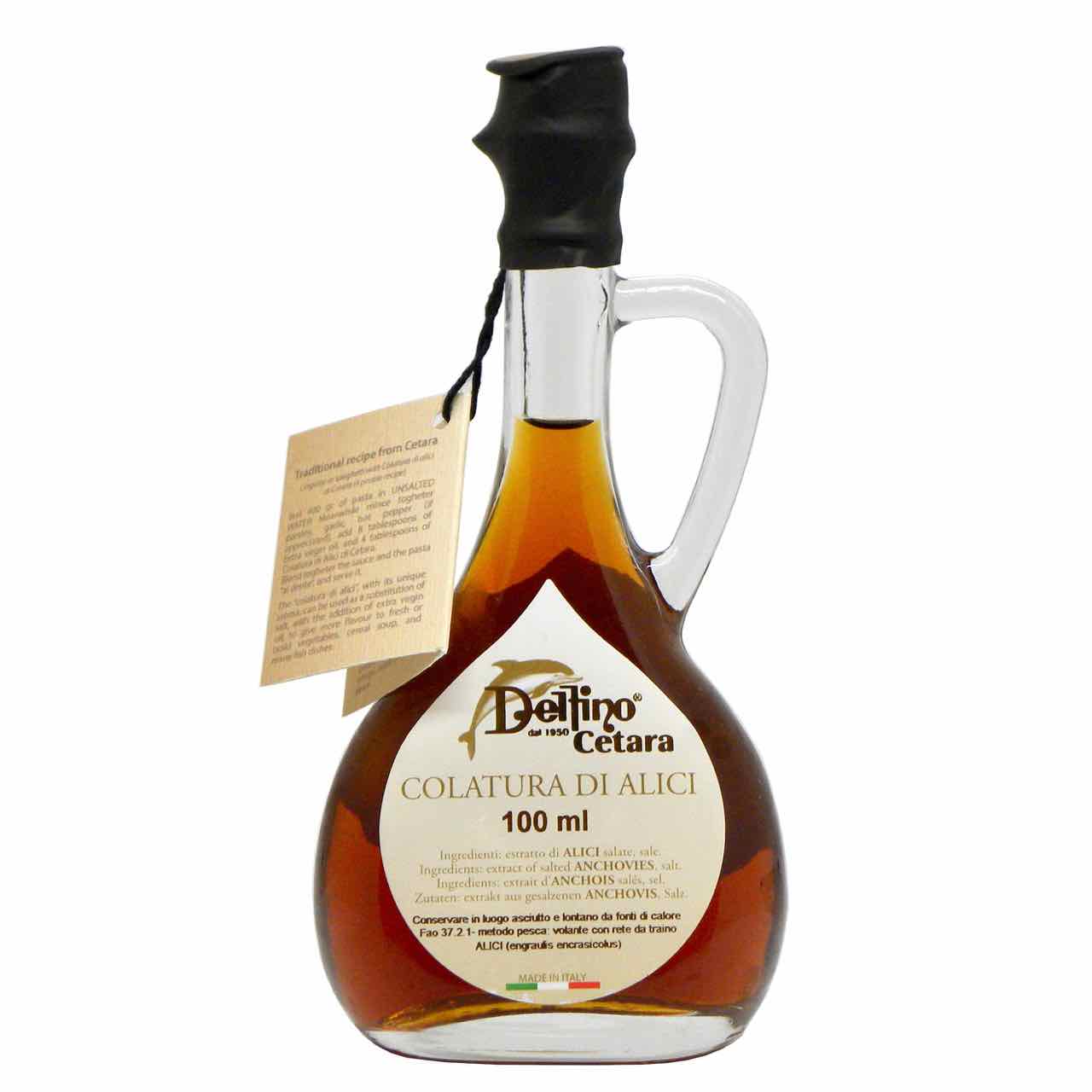Description
The Anchovies Sauce from Cetara is a translucent amber liquid obtained from the skilful seasoning and pressing of anchovies left to ripen with salt in special wooden casks.
The extract od anchovies is a genuine food, easy to digest and rich in vitamin A.
Amber in colour and balanced to the taste albeit rather strong, the Colatura di alici offers a rich bouquet of intense aromas associated with the Mediterranean.
DELFINO BATTISTA'S ANCHOVIES SAUCE: INGREDIENTS
Salted anchovy extract, salt.
WHY GUSTOROTONDO CHOSE DELFINO BATTISTA
Gustorotondo selected Delfino Battista for the authentic flavours and for the attention the company dedicates to the ingredients and to the production processes.
COLATURA DI ALICI DI CETARA DELFINO BATTISTA: THE MAKING

Colatura di alici translates to Dripping of anchovies (the Italian verb colare means to drip).
It is a typical and traditional specialty of Cetara, a translucent amber liquid obtained from the skilful seasoning and pressing of anchovies left to ripen with salt in special wooden casks.
The tiny silvery anchovies are alternately layered with salt inside small wooden casks called terzigni. The name terzigno (terzigni is plural) comes from the fact that the size of the cask is one third (in Italian un terzo) of a barrel.
Completed the layers, anchovies and salt are covered with a wooden disc, and a weight is put on it.
Due to the pressing and to the ripening of anchovies, a liquid is produced.
The liquid that is first produced is thrown away; the liquid produced when the anchovies are more ripe, instead, is collected and then poured back in the terzigno still full of the anchovies:
passing slowly through the various layers of anchovies and salt it will collect their organoleptic characteristics.
The liquid is then recovered through a small hole at the bottom of the terzigno and filtered.
The very essence of anchovy is ready.
COLATURA DI ALICI DI CETARA DELFINO BATTISTA: PAIRINGS
Colatura di Alici combined with a good olive oil can be used to season fresh or boiled (e.g. potatoes and broccoli) vegetables, cereal soups and fish dishes.
It also pairs greatly spaghetti in the classic recipe Spaghetti con colatura di alici.
SPAGHETTI WITH COLATURA DI ALICI
Spaghetti with Anchovies Sauce is an extremely simple dish. It can be cooked by anyone and it doesn’t take much time.
The spaghetti al dente and the strong flavour of the Colatura will bring you pure pleasure: here is an important part of the true essence of the magnificent culinary tradition of the Amalfi Coast.
Ingredients:
- Spaghetti
- Parsley
- Garlic
- Chilli pepper
- Extra virgin olive oil
- Colatura di alici (Anchovies Sauce)
Directions:
- Cook the pasta in unsalted boiling water (the Alici sauce is enough salted!)
- Meanwhile, chop some parsley, garlic and peperoncino (optional) and put them in a pan. Add two tablespoons of extra virgin olive oil per person and half a tablespoon of Delfino Battista colatura di alici di Cetara per person.
- Drain the pasta when it is al dente and add it to the pan with a little of pasta-cooking water
- Add parsley
- Mix well, and serve!
DELFINO BATTISTA: TRUE FLAVOURS OF THE AMALFI COAST
Just after the Second World War Pasquale Battista opened a small food laboratory where he worked with passion and pride, mainly producing preserved anchovies.
During the 1990s Pasquale Battista’s sons took over the the activity, and they are now carrying on the tradition of preserving anchovies thanks the expertise and teaching of their father.
Delfino Battista processes the ingredients with care and patience, and some parts of the process, as packaging, are done by hand.
All Delfino Battista’s products are chemical and additive free, keeping intact quality and flavours.
The highly-selected ingredients and the careful workmanship guarantee genuine products, suitable for a healthy and balanced diet.

Delfino Battista’s story is deeply rooted in a delightful, small fishing village of the Costiera Amalfitana, Cetara.
In Ancient times, many Mediterranean places were called Taricheiai (in Greek) or Cetaria (in Latin). The name derives from the fact that in those places there were places for the processing of fishes: cetariae were basins which were used in the production of fish sauces or other salted fish products.
In the Middle Ages nearly all the Roman processing places became tuna-fishing plants and the production of garnishes and dressings became much less popular. In Cetara, Delfino Battista still carries on the tradition of fish processing and producing gourmet delicacies.












Customers review
Rate it!
Only logged in customers who have purchased this product may leave a review.
Write A ReviewReviews
There are no reviews yet.